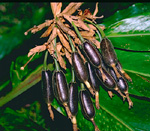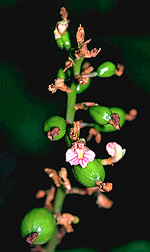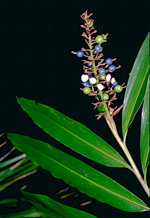 |
This is a tropical family from warm, moist, lowland rainforests principally in south-east Asia but extending to tropical Africa and Central America. In Australia it occurs from Cape York to northern New South Wales.
Characteristic features of the family Zingiberaceae in Australia include: - robust herbs, often aromatic, with large, 2-ranked alternate leaves often with a well-developed sheathing petiole and broad, strongly-veined blade
- flowers usually borne in brightly-coloured bracteate spikes, sometimes from ground level, strongly zygomorphic with a tubular, petaloid perianth and sometimes with 2 petaloid sterile stamens
- fertile stamens 1, often curved and sometimes with a crested anther
- ovary inferior, with 2 needle-like outgrowths from its apex
- fruit a capsule or fleshy berry
Description
Perennial terrestrial herbs. Perennating by rhizomes. Vegetative reproduction by rhizomes. Internal secretions of essential oils. Plants glabrous. Leaves distichous, cauline, petiolate. Stipule-like lobes absent. Lamina simple, symmetric, filiform, acicular, subulate, linear, lanceolate, ovate, elliptic or oblong; base cuneate, attenuate, rounded or cordate; margins entire; venation pinnate, with the midrib conspicuous, and the tertiary venation not reticulate; surfaces not punctate; herbaceous; distinctive odour aromatic. Leaf ligule present. All the flowers bisexual. Inflorescences terminal, consisting of spikes or monochasial cymes. Bracts present. Bracteoles present or absent. Pollination by insects. Flowers odourless or fragrant, sessile or stalked. Floral disc absent; nectaries present on the carpels. Perianth of 2 dissimilar whorls. Calyx regular or irregular; segments fused, with 3 lobes, valvate in bud; calyx funnel-shaped or tubular, herbaceous. Corolla irregular; segments fused, with 3 lobes, alternating with the calyx lobes, imbricate in bud; corolla funnel-shaped, 1-lipped, white, yellow, red, pink, magenta, purple or green, without contrasting markings, or streaked, spotted, etc, membranous; lobes ±entire. Fertile stamen 1, alternating with the calyx lobes, free of the corolla, free of the ovary and style, distinct from each other. Staminal filaments present or absent. Anthers dorsifixed, versatile or not versatile, opening inwards by longitudinal slits, 2-celled; appendages apical or basal. Ovary inferior. Carpels 3, fused; ovary with 1 or 3 locules. Style terminal, single and unbranched and the stigma clavate. Ovules 4–numerous per locule, sessile; placentation parietal or axile. Fruit fleshy, dehiscent or indehiscent; a capsule with irregular or loculicidal dehiscence, or a berry. Disseminule micro-surface ±smooth, orange, red, magenta, purple, violet, brown or grey. Seeds 12–numerous per fruit. Aril present. Cotyledons 1. Embryo straight.
(Note: this description has been generated from the coded data compiled for the key. Any errors in the key data will be reflected in the descriptions.)
A treatment of the family Zingiberaceae has been published in:
Flora of Australia 45: 19-34.
Australian genera of Zingiberaceae (as recognised for the Flora of Australia)
* = all species introduced
Alpinia
Amomum
Curcuma
Etlingera
Globba
*Hedychium
Hornstedtia
*Kaempferia
*Zingiber

|
  |

Alpinia arctiflora (flowers)
Photo: H.Nicholson © H. & N. Nicholson

Alpinia arctiflora (fruits)
Photo: D.Jones © D.Jones

Alpinia arundelliana (flowers and fruits)
Photo: D.Jones © D.Jones

Alpinia caerulea (fruits)
Photo: M.Fagg © M.Fagg

|
 |
|